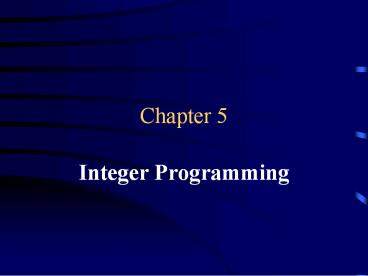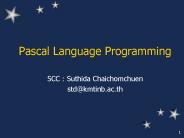Integer Programming - PowerPoint PPT Presentation
Title:
Integer Programming
Description:
Chapter 5 Integer Programming – PowerPoint PPT presentation
Number of Views:69
Avg rating:3.0/5.0
Title: Integer Programming
1
Chapter 5
- Integer Programming
2
What is an integer program (IP)?
- IP is a linear program in which all or some
variables can only take integral values. - A satisfiable solution of IP cannot be obtained
by rounding the corresponding LP solution. - Solution method of IP is different from, and more
difficult than, solution method of LP.
3
Example, p.185
- Machine Space Unit Profit
- required Price predicted
- Press 15 ft2/unit 8,000 100/day
- Lathe 30 ft2/unit 4,000 150/day
- There are 200 ft2 and 40,000 available.
- How many presses and lathes to purchase to
maximize daily profit?
4
Example
- Investment Cost Profit Available
- opportunity per unit per unit (units)
- Condominium 50,000 9,000 4
- Land 12,000 1,500 15
- Bond 8,000 1,000 20
- There are 250,000 available.
- Where to invest to maximize the profit?
5
Types of IP models
- Total IP model
- All variables must be integral.
- 0-1 IP model
- Variables can be 0 or 1 only.
- Mixed IP model
- variables can be 0-1, integral or non-integral.
6
Logical Representations by Using 0-1 variables
- 0-1 variables is used to represent various
logical relationships in integer programming
formulations.
7
0-1 variables
- Let
- i1, 2, 3,
8
Mutually exclusive relation.
- Either X1 or X2 (but not neither, not both)
- X1X21
9
Contingency relation
- Either X1 or X2, or neither (but not both)
- X1X2lt1
- At least one of X1 and X2
- X1X2gt1
10
Co-requisite Relation
- X1 and X2 must be on or off together
- X1X2
11
Mutually exclusiveness on more than two variables
- Select exactly one of X1, X2, X3
(Multiple-choice relation) - X1X2X31
12
Contingency relations on more than two variables
- Select no more than one from X1, X2, X3
- X1X2X3lt1
- Select no more than two from X1, X2, X3
- X1X2X3lt2
- Select at least one of X1, X2, X3
- X1X2X3gt1
13
Conditional relation (if then )
- If X1 is on, then X2 must be on, (and if X1
is off then X2 can be either on or off.) - X1ltX2
14
Example, p.186
- Facility Usage Cost Land (acres)
- considered people/day required
- Swimming pool 300 35,000 4
- Tennis center 90 10,000 2
- Athletic field 400 25,000 7
- Gymnasium 150 90,000 3
- There are 12 acres and 120,000 available.
- (continued on next page)
15
Example, p.186 (cont.)
- Additional restriction on selection of the
facilities - (1) Between swimming pool and tennis center, only
one can be constructed. - (2) Between athletic field and tennis center, at
least one must be built. - (3) If athletic field is built, then swimming
pool must be built. - (4) Among the four, at least two must be built.
- Which facilities should be constructed to
maximize the daily usage?
16
Example p.205 A Set Covering Problem
- APS wants to build package distribution hubs to
cover 12 cities. A hub can cover cities within
300 miles, as shown on p.205. - Which cities should be selected as hubs so that
number of hubs to be built is minimized?
17
Example p.205 Define Variables
- xi 0 if city i is not selected as a hub, and
- xi 1 if city i is selected as a hub
- where i 1, 2, 3, , 12 such that
- 1 for Atlanta, 2 for Boston 3 for Charlotte
- 4 for Cincinnati 5 for Detroit 6 for
Indianapolis - 7 for Milwaukee 8 for Nashville 9 for New York
- 10 for Pittsburgh 11 for Richmond 12 for St.
Louis
18
Example p.205 Set up Integer Program
- Minimize total number of hubs to build
- For each of the 12 cities
- It must be covered by at least a hub within 300
miles i.e., there must be at least a hub within
300 miles of it. - The complete integer program is on p.206.
19
Solution Methods of IP
- Solving IP is more complicated than solving LP.
Two main solution methods of IP - Branching and bound method
- Cutting plain method
20
Integer Programming (IP), Discrete Optimization,
and NP Complete
- An integer program has finite number of feasible
solutions. - IP is a typical problem of discrete optimization
that selects the best from a finite number of
alternatives. - IP is a computationally hard problem (NP complete
problem). That is, no method has been found to
solve IP efficiently.































